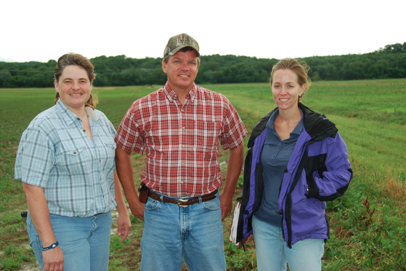|
|
Jim Hoene stood in a large equipment shed on the Jefferson County property along the Big River that he has been farming for 30 years. Torrents of rain beating on the tin roof caused him to speak loudly to be heard above the roar.
A few years earlier, in a similar situation, he might have expressed concern about getting his crops in, and keeping those already planted from washing away. But he wasn’t worried this year.
“These are the days that we plan for,” he said calmly.
More than 1,200 acres of the 1,400 acres that Hoene farms are in the floodplains of the Meramec River or Big River. Years ago he worked with the Natural Resources Conservation Service (NRCS) to install terraces to direct runoff into the Big River.
That took care of the surface water, but seep water still kept the land wet. With the assistance of David Skaer, an NRCS soil scientist, Hoene was able to determine the paths of the subsurface water. He then installed 2 miles of 8-inch underground pipe that collects the water and deposits it into a wetland along the river.
“That tile has been running almost constantly,” Hoene said. “It solved a problem that I had on 80 acres that had a hard time drying out.”
A strong proponent of no-till farming, Hoene found that his water-management practices and his tillage practices were working together to improve the efficiency and productivity of his operation.
“Now we can no-till a lot more successfully because before we didn’t have oxygen in our soil; all we had was water,” he said. “But even as wet as this spring was, we were able to get all of our crops planted.
“In a year like this, I don’t know what I would have done without no-till. We only had an 11-day window to get a crop in.”
With surface water management, subsurface water management and no-till working together, Hoene’s farming operation was rounding into shape. But there was still one more problem.
“We were losing a lot of the benefits of no-till because the river floods and washes the residue away,” he said.
In an attempt to reduce that problem, Hoene signed up to participate in an NRCS program that provides incentives to establish cover crops.
The benefits of cover crops are that they keep residue from washing away, they provide soil surface cover in the winter, and they help remove excess water from the soil in the spring, said Rhonda Davault, NRCS District Conservationist.
In the first year of planting a cover crop of ryegrass, Hoene found that the benefits were even greater.
“The ryegrass not only held the soil and residue in place, but it also gathered sediment during floods,” he said.
He added that the thick, deep roots of the ryegrass could benefit crops by loosening the soil.
“We’ve never given the underground climate the attention it deserves. Everybody’s looking at what’s going on up top,” Hoene said.
“Jim is one of the first farmers in Jefferson County to try cover crops,” said LeAnn Schmidt, an NRCS soil conservationist who has provided technical assistance to Hoene relative to conservation measures.
She said that Hoene is receiving financial assistance through NRCS’ Environmental Quality Incentives Program to try cover crops and also for nutrient and pest management efforts. The initial results show that the ryegrass, which has thicker and deeper roots than wheat, could help promote crop root growth, Schmidt said.
Hoene said he has thought about trying cover crops, but the NRCS program gave him the incentive to try it on his farm.
“It’s kind of like when you are a kid on the edge of a diving board and your friend pushes you off. NRCS pushed me off,” Hoene said. “With the help of NRCS, I’ve learned how to establish cover crops and see the benefits.”

 The Jim Hoene Farm (NRCS photo).
The Jim Hoene Farm (NRCS photo).




Post a comment
Report Abusive Comment